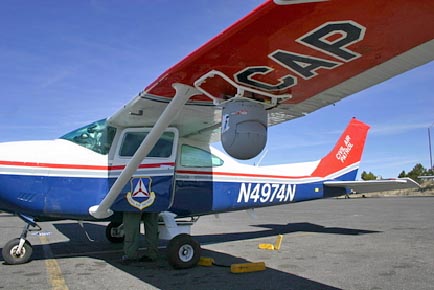|

Ken Phillips/NPS
Contact: Shannan Marcak, 928-638-7958 Contact: Maureen Oltrogge, 928-638-7779
Grand Canyon, Ariz. – On Thursday, March 31, members of Civil Air Patrol's (CAP) Nevada Wing joined the search for Joseph Radford in Grand Canyon National Park. The National Park Service (NPS) and Coconino County Sherriff's Office (CCSO) have been searching for Radford for almost three weeks since determining that he and his plane were last seen on Friday, March 11, at the Grand Canyon Airport located just south of Grand Canyon National Park. During the search, a NPS helicopter and fixed wing aircraft flew approximately 2,000 air miles over a search area originally estimated at 600 square miles. To date, no signs of Radford's plane or of a crash site have been detected. With the search area thoroughly covered by the available technology and weather worsening, search and rescue (SAR) personnel last week turned their efforts toward sorting and analyzing the clues investigators had been gathering while the search progressed. On Tuesday, March 29, NPS and CCSO staffs, CAP and Air Force Rescue Coordination Center technical experts gathered to analyze those investigative clues alongside the latest interpretations of the technical data. Through their analysis, SAR personnel were able to define smaller areas within the larger search zone that could be searched again with more advanced technology. Yesterday, members of CAP's Nevada Wing used a Surrogate Predator aircraft to search six areas in the Fossil Corridor identified as probable areas where Radford's plane may have gone down. Today, the CAP crew will complete their flights over the six search areas and will provide the Surrogate Predator footage to park staff for review. The Surrogate Predator's sensor ball, mounted underneath the wing of a CAP Cessna 182, provides high resolution imagery. The areas where CAP pilots are focusing their efforts were identified based on FAA radar track and cell phone signal analysis, as well as visual sightings. This is the first time a Surrogate Predator has been used for a search mission. To date, CAP has relied upon this new technology to help train soldiers and airmen for combat operations overseas. After today's flight, the NPS will analyze the new imagery provided by the Surrogate Predator in a continued effort to locate the missing plane. If the plane is not located today, search activities will continue on a limited basis as new evidence and information becomes available. For more information on the use of the Surrogate Predator in the search for Mr. Radford, please contact Colonel John Varljen, CAP, at 928-595-0206. -NPS-
|
Last updated: February 24, 2015
